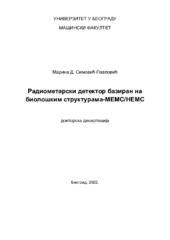Приказ основних података о дисертацији
Радиометарски детектор базиран на биолошким структурама-МЕМС/НЕМС
Radiometric detector based on biological structures - MEMS / NEMS
| dc.contributor.advisor | Micković, Dejan | |
| dc.contributor.other | Vasiljević, Darko | |
| dc.contributor.other | Elek, Predrag | |
| dc.contributor.other | Pavlović, Vera | |
| dc.contributor.other | Todić, Ivana | |
| dc.creator | Simović-Pavlović, Marina | |
| dc.date.accessioned | 2024-03-13T15:46:07Z | |
| dc.date.available | 2024-03-13T15:46:07Z | |
| dc.date.issued | 2022-09-09 | |
| dc.identifier.uri | https://uvidok.rcub.bg.ac.rs/doccall/bitstream/handle/123456789/4812/Referat.pdf | |
| dc.identifier.uri | https://eteze.bg.ac.rs/application/showtheses?thesesId=9563 | |
| dc.identifier.uri | https://fedorabg.bg.ac.rs/fedora/get/o:32992/bdef:Content/download | |
| dc.identifier.uri | https://plus.cobiss.net/cobiss/sr/sr/bib/75800073 | |
| dc.identifier.uri | https://nardus.mpn.gov.rs/handle/123456789/22274 | |
| dc.description.abstract | Инфрацрвени детектори су у великој употреби данас и имају примену на разним пољима. Посебну примену термовизија има у војне сврхе. Термалне камере формирају слику користећи инфрацрвено зрачење, а формирана слика детектованог зрачења назива се термограм. Како сваки објекат са температуром изнад апсолутне нуле емитује инфрацрвено зрачење, термографија је метода посматрања објеката са или без видљивог осветљења. Ове карактеристике чине термовизијске уређаје ефикасним при ноћном осматрању и осматрању у условима смањене видљивости. Постоје две велике групе инфрацрвених детектора, термални и квантни. Термални детектори су, иако дају спорији одговор, практичнији за примену јер не захтевају хлађење, односно раде на собној температури. Самим тим, њихова производња је једноставнија и приступачнија. Константна је потреба за проналажењем нових механизама-сензора, који ће превазићи досадашња ограничења детекције термалног зрачења. Један од начина детекције тзв. топлотног (термалног) електромагнетног зрачења је заснован на употреби радиометарског ефекта. Ради се о термо-механичкој појави која настаје када је електромагнетно зрачење апсорбовано на комаду материјала, тако да се на њему формира градијент температуре, док је истовремено средњи слободни пут молекула окружујућег гаса приближно једнак карактеристичној димензији комада материјала. Радиометарски ефекат је заснован на чињеници да молекули окружујућег гаса односе много више механичког импулса са топлије стране материјала у односу на хладнију страну, чиме се формирају силе које називамо радиометарске, а које доводе до механичког померања материјала. Претварање енергије невидљивог електромагнетног зрачења у механички померај микромеханичког детекционог система, и то таквог да је величина механичког помераја сразмерна енергији, мери се методом холографске интерференције. Крила различитих лептира коришћена су за конструисање новог инфрацрвеног сензорног система. Коришћена је промена спектра боја на природној структури крила лептира, изазвана термалним утицајем, и фотофоретски ефекат као последица процеса. Истраживање је обухватило одређивање утицаја различитих параметара на ефекат и довело је до значајних закључака у правцу једнозначног одређивања главног фактора који одређује јачину фотофоретског ефекта, коругацију биофотонске структуре. Дисертација, односно њен крајњи резултат у виду предлога радиометарског детектора базираног на биолошким структурама, је моћна комбинација спознаје до сада неоткривених својстава ефекта термофорезе у теоријском и експериманталном смислу и практичне, инжењерске примене и пласирања холографске методе за иновативна испитивања биолошких и других нано материјала, односно посматрања динамике нано процеса. | sr |
| dc.description.abstract | Today, infrared detectors are broadly used for various applications. Thermal imaging has a particular application for military purposes. Thermal cameras form an image using infrared radiation, and the created image of detected radiation is called a thermogram. Since every object with a temperature above absolute zero emits infrared radiation, thermography observes entities without the need for additional illumination. These features make thermal imaging devices effective at night and in low visibility conditions. There are two significant groups of infrared detectors, thermal and quantum. Although thermal detectors give a slower response, they are more practical because they operate at room temperature without the need for additional cooling, and their manufacturing is more straightforward and less expensive. However, there is a constant need to find new mechanisms, which will overcome the current limitations in the detection of thermal radiation. One of the new ways to detect thermal radiation is based on the radiometric effect. The radiometric effect is a thermo-mechanical phenomenon that occurs when electromagnetic radiation is absorbed on a piece of material, so the temperature gradient is formed on it. At the same time, the mean free path of the surrounding gas molecules is approximately equal to the characteristic dimension of the material architecture or sub-architecture. Since the molecules of the surrounding gas carry much more mechanical impulse from the warmer side of the material compared to the colder side, thus forces called radiometric occur, which leads to mechanical displacement. Shortly, the radiometric detector is intended to detect invisible parts of the electromagnetic radiation spectrum, harnessing motions of submillimeter size particles caused by interaction with surrounding gas atoms or molecules. The conversion of the energy of invisible electromagnetic radiation into mechanical displacement is detected by the holographic method. The complex nanoarchitecture of butterflies’ wings offers the possibility of combining the power of photonics with the chance of detecting infrared radiation by molding the photophoretic effect. The strength of the photophoretic response is the function of nano-corrugation of natural photonic structures, their size, and shape and that is the main findings of the research presented in this thesis. The result of this dissertation, ie a radiometric detector proposal based on biological structures, is a powerful combination of knowledge of hitherto undiscovered properties of the thermophoretic effect in theoretical and experimental terms and practical, engineering application of holographic methods for innovative testing of biological nanomaterials and observations of nano process dynamics. | en |
| dc.format | application/pdf | |
| dc.language | sr | |
| dc.publisher | Универзитет у Београду, Машински факултет | sr |
| dc.rights | openAccess | en |
| dc.source | Универзитет у Београду | sr |
| dc.subject | термална камера, радиометарски детектор, ИЦ зрачење, холографија, Био НЕМС, фотофореза | sr |
| dc.subject | Thermal camera, Radiometric detector, IR radiation, Holography, Bio-MEMS, Photophoresis | en |
| dc.title | Радиометарски детектор базиран на биолошким структурама-МЕМС/НЕМС | sr |
| dc.title.alternative | Radiometric detector based on biological structures - MEMS / NEMS | en |
| dc.type | doctoralThesis | |
| dc.rights.license | ARR | |
| dc.identifier.fulltext | http://nardus.mpn.gov.rs/bitstream/id/159841/Disertacija_15149.pdf | |
| dc.identifier.fulltext | http://nardus.mpn.gov.rs/bitstream/id/159842/Izvestaj_Komisije_15149.pdf | |
| dc.identifier.rcub | https://hdl.handle.net/21.15107/rcub_nardus_22274 |



